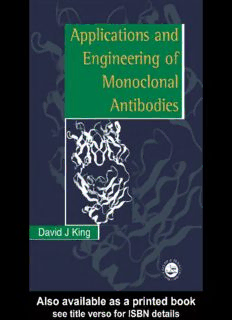
Applications And Engineering Of Monoclonal Antibodies PDF
Preview Applications And Engineering Of Monoclonal Antibodies
Applications and Engineering of Monoclonal Antibodies Applications and Engineering of Monoclonal Antibodies DAVID J.KING Celltech Therapeutics Slough, UK UK Taylor & Francis Ltd, 1 Gunpowder Square, London EC4A 3DE USA Taylor & Francis Inc., 325 Chestnut Street, 8th Floor, Philadelphia, PA 19106 This edition published in the Taylor & Francis e-Library, 2005. “To purchase your own copy of this or any of Taylor & Francis or Routledge’s collection of thousands of eBooks please go to www.eBookstore.tandf.co.uk.” Copyright © D.J.King 1998 All rights reserved. No part of this publication may be reproduced, stored in a retrieval system, or transmitted, in any form or by any means, electronic, electrostatic, magnetic tape, mechanical, photocopying, recording or otherwise, without the prior permission of the copyright owner. Every effort has been made to ensure that the advice and information in this book is true and accurate at the time of going to press. However, neither the publisher nor the author can accept any legal responsibility or liability for any errors or omissions that may be made. In the case of drug administration, any medical procedure or the use of technical equipment mentioned within this book, you are strongly advised to consult the manufacturer's guidelines. British Library Cataloguing-in-Publication Data A catalogue record for this book is available from the British Library ISBN 0-203-21169-3 Master e-book ISBN ISBN 0-203-26917-9(cid:13) (Adobe eReader Format) ISBN 0-7484-0422-8 (hb) 0-7484-0423-6 (pb) Library of Congress Cataloging Publication Data are available Cover design by Youngs Design in Production Acknowledgements I would like to thank my many colleagues at Celltech for their helpful suggestions and advice, and particularly Alastair Lawson and Martyn Robinson for their comments on the manuscript. Thanks also to Tina Jones for assistance with the figures. And lastly, sincere thanks to my wife, Jane, for her support and patience through the long hours and weekends spent writing this book. Contents 1 Preparation, structure and function of monoclonal antibodies 1 1.1 Introduction 1 1.2 The role of antibodies in the immune response 1 1.3 Structure and function of antibodies 2 1.4 The organisation of antibody genes 11 1.5 Antigen-binding affinity and avidity 11 1.5.1 Affinity 11 1.5.2 Avidity 13 1.6 Generation of monoclonal antibodies 14 1.6.1 Hybridoma technology 14 1.6.2 Human monoclonal antibodies 17 1.6.3 Human MAbs from transgenic mice 19 1.6.4 Isolation of antibodies by phage display 20 2 Antibody engineering: design for specific applications 26 2.1 Introduction 26 2.2 Isolation of variable region genes 27 2.3 Overcoming immunogenicity 28 2.3.1 Chimeric and humanised antibodies 28 2.3.2 Antibody fragments to reduce immunogenicity 35 2.3.3 Chemical modification to reduce immunogenicity 36 2.3.4 Immunosuppressive therapy 37 2.4 Antibody fragments 38 2.4.1 Antibody fragments from proteolysis of IgG 38 2.4.2 Recombinant antibody fragments 40 Fab-based fragments 41 vi Fv-based fragments 41 Multivalent antibody fragments 44 2.5 Antibodies with multiple specificities 47 2.6 Engineering effector functions 51 2.6.1 Engineering natural effector functions 51 2.6.2 Attachment of diagnostic or therapeutic agents 55 Chemical conjugates 55 Site-specific attachment 60 Fusion proteins 62 2.7 Engineering pharmacokinetics and biodistribution 64 2.7.1 Pharmacokinetics of IgG 64 2.7.2 Pharmacokinetics of antibody fragments 67 2.7.3 Clearance 70 2.7.4 Chemical modification 70 2.7.5 Fc region to extend half-life 71 3 Monoclonal antibodies in research and diagnostic applications 72 3.1 Introduction 72 3.2 Immunoassays in diagnostics and research 72 3.2.1 Radioimmunoassay 73 3.2.2 Immunoradiometric assay 74 3.2.3 Non-isotopic immunoassays 78 3.2.4 Improving sensitivity 80 3.2.5 Assay formats 84 3.2.6 Advantages of monoclonal antibodies in immunoassay 85 3.3 Immunosensors 87 3.3.1 Mass-detecting immunosensors 87 3.3.2 Electrochemical immunosensors 88 3.3.3 Optical immunosensors 89 3.4 Immunocytochemistry 90 3.5 Flow cytometry and cell sorting (FACS) 93 vii 3.6 Western blotting (immunoblotting) 94 3.7 Immunopurification 96 3.8 Antibodies in structural biology 99 3.9 In vivo diagnostics 100 3.9.1 Radioimmunodetection of human tumours 101 Tumour-associated antigens 101 Form of antibody 102 Radioisotopes 103 Two- and three-step targeting approaches 105 3.9.2 Radioimmunoguided surgery 109 3.9.3 Non-tumour radioimmunodetection 109 4 Monoclonal antibodies in therapeutic applications 112 4.1 Introduction 112 4.2 Cancer 113 4.2.1 Cancer therapy with unmodified (naked) antibodies 113 4.2.2 Anti-idiotype antibodies 115 4.2.3 Bispecific antibody-mediated effector cell targeting 116 4.2.4 Other approaches to recruit the immune system using MAbs 119 4.2.5 Radioimmunotherapy 120 Form of antibody 121 Radioisotopes 123 Clearance mechanisms and two-step targeting 128 Clinical results with RIT 129 4.2.6 Immunotoxins 131 4.2.7 Drug conjugates 134 4.2.8 Antibody-directed enzyme prodrug therapy (ADEPT) 135 4.2.9 Vascular targeting 137 4.3 Infectious disease 138 4.3.1 Antiviral antibodies 138 4.3.2 Bacterial sepsis 140 viii 4.4 Cardiovascular disease 141 4.4.1 Inhibition of platelet aggregation 141 4.4.2 Thrombolysis 141 4.5 Disorders of the immune system/inflammatory diseases 142 4.5.1 The inflammatory response 142 4.5.2 Blocking inflammatory mediators 144 Anti-TNF antibodies in rheumatoid arthritis and inflammatory bowel disease 144 Anti-C5 145 4.5.3 Blocking adhesive interactions 145 4.5.4 Antibodies which directly inhibit T cell activation and proliferation 146 4.5.5 Antibody treatment of allergy 149 5 Production of monoclonal antibodies 151 5.1 Introduction 151 5.2 Expression of antibodies in mammalian cells 151 5.2.1 Transient expression systems 152 5.2.2 Stable expression systems 153 5.2.3 Expression of antibody fragments in mammalian cells 156 5.3 Expression in Escherichia coli 157 5.3.1 Intracellular expression of antibody fragments in E. coli 158 5.3.2 Secretion of antibody fragments from E. coli 159 5.4 Expression in other microbial systems 162 5.5 Expression in plants 163 5.6 Production in transgenic animals 164 5.7 Expression in insect cells 164 5.8 Production of monoclonal antibodies—cell culture 165 5.9 Purification of monoclonal antibodies 165 5.9.1 Purification of IgG 165 5.9.2 Purification of IgM 170 5.9.3 Purification of monoclonal antibody fragments 170 5.9.4 Purification for therapeutic use 173 ix 6 Prospects for engineered antibodies in biotechnology 175 6.1 Gene therapy 175 6.1.1 Intracellular antibodies 175 6.1.2 Other applications of MAbs in gene therapy 176 6.2 Applications of antibodies in plants 177 6.3 Catalytic antibodies 177 6.4 Towards drug design 178 6.5 Improving affinity 179 6.6 Summary and prospects 180 7 References 181 Index 225
Description: